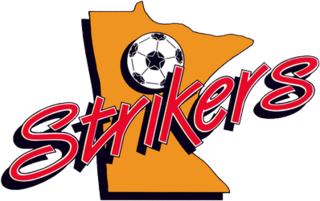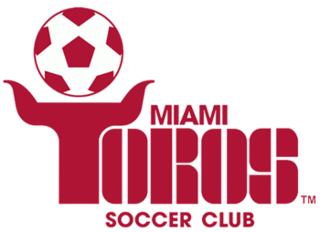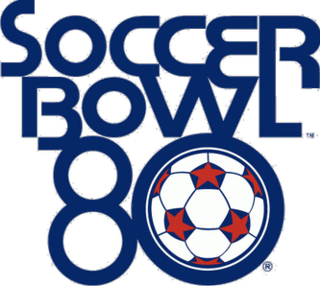
The North American Soccer League (NASL) was the top-level major professional soccer league in the United States and Canada that operated from 1968 to 1984. It is considered the first soccer league to be successful on a national scale in the United States. The league final was called the Soccer Bowl from 1975 to 1983 and the Soccer Bowl Series in its final year, 1984. The league was headed by Commissioner Phil Woosnam from 1969 to 1983. The NASL laid the foundations for soccer in the United States that helped lead to the country hosting the 1994 FIFA World Cup and the set-up of Major League Soccer (MLS) in 1996.

The Minnesota Strikers were an American soccer team that competed in the North American Soccer League (NASL) for the 1984 season and in the Major Indoor Soccer League from 1984 through 1988. The team was based in Minneapolis/St. Paul metropolitan area and played their outdoor home games at Hubert H. Humphrey Metrodome and the Met Center for indoor games. Founded in 1967 as the Washington Darts and playing in Miami as the Gatos and the Toros before playing seven season as the Fort Lauderdale Strikers the team left Florida following the 1983 North American Soccer League season. After the 1987–88 season and playing four seasons in the MISL the team ceased operations.

The Los Angeles Aztecs were an American professional soccer team based in Los Angeles, California that existed from 1974 to 1981. The Aztecs competed in the North American Soccer League (NASL) from 1974 to 1981 as well as the 1975 NASL Indoor tournament, the 1979–80 and 1980–81 NASL Indoor seasons, and won the NASL Championship in 1974. During their eight years of existence, the Aztecs played at four different venues and were controlled by four different ownership groups, European soccer legends George Best and Johan Cruyff played for the team, and from 1975 to 1977 English singer Elton John was a part-owner.

The Miami Toros were a professional soccer team in the North American Soccer League from 1972 to 1976. The club was founded in 1967 as the Washington Darts, and moved to Miami, where they played the 1972 season in the NASL's Southern Division as the Miami Gatos. In 1973, the club rebranded as the Miami Toros. Their home field was at times the Miami Orange Bowl, Tamiami Field and Miami Dade College's North Campus Stadium.

The Fort Lauderdale Strikers were an American professional soccer team based in Fort Lauderdale, Florida founded in 2006, that last played in the North American Soccer League (NASL), the second tier of the American soccer pyramid in 2016. The majority of their home games were played in Lockhart Stadium. The Strikers were named after the original Strikers, who played in the old North American Soccer League from 1977 to 1983.

Steve Wegerle is a South African former professional soccer player who played as a winger.
Mike Connell is a former professional footballer who spent most of his career as a defender. He played professionally in his native South Africa as well as in the North American Soccer League (NASL), mostly with the Tampa Bay Rowdies.
The Fort Lauderdale Strikers were an American soccer team established in 1988 as part of the third American Soccer League. In 1990, it moved to the American Professional Soccer League where it spent five seasons before folding in 1994. The Strikers won the 1989 ASL championship, as well as the 1989 National Pro Soccer Championship.
Statistics of North American Soccer League in season 1977. This was the 10th season of the NASL.
Ken Fogarty is a (naturalised) American soccer coach. Fogarty was Head Coach and Technical Director of the Cayman Islands national team from 1993 to 1994 and from 1996 to 1998.
Eugene Van Taylor is a retired American soccer goalkeeper who spent two seasons in the North American Soccer League, three in the American Soccer League and five in the Major Indoor Soccer League. He retired in 2015 after thirty years as the head coach of the men's soccer program at Lander University.
Guy Newman is a retired English-American soccer defender who played in the North American Soccer League, American Soccer League and Major Indoor Soccer League. He is currently coaching at East County Surf Soccer Club.
The 1983–84 North American Soccer League indoor season was the fourth and last in league history. The San Diego Sockers defeated the New York Cosmos for their third straight indoor title, having won the NASL Indoor title in 1981–82 and the MISL title in 1982–83.

The Fort Lauderdale–Tampa Bay rivalry, also known as the Florida Derby, refers to the suspended soccer rivalry that most recently involved the Fort Lauderdale Strikers and the Tampa Bay Rowdies, both of whom played in the North American Soccer League through the 2016 season. Over the years the rivalry has spanned more than one hundred matches across eight soccer leagues and several tournaments, and involved nine different teams from the two regions of Florida. At times it has involved players, coaches, management and fans. Even the press has fanned the rivalry's flames at times. From 2010 through 2014, the winner of the regular season series automatically won the Coastal Cup as well. The status of the rivalry beyond 2016 remains unclear because the Rowdies have since joined the United Soccer League, while the Strikers ongoing ownership and legal battles of 2016 and 2017 have left them defunct.
The 1975 Tampa Bay Rowdies season was the first season of the club's existence.
The 1983 NASL Grand Prix of Indoor Soccer was an indoor soccer tournament staged by four franchises of the North American Soccer League.

Soccer Bowl '80 was the championship final of the 1980 NASL season. The New York Cosmos took on the Fort Lauderdale Strikers. The match was played on September 21, 1980 at RFK Stadium in Washington, D.C. The Cosmos won, 3–0, to claim their fourth league championship, and third in the past four seasons.
The 1979 NASL Budweiser Indoor Soccer Invitational was a four-team indoor soccer tournament held at the Bayfront Center in St. Petersburg, Florida on the final weekend of January 1979.
The Philadelphia Fury were an American soccer team that competed in the North American Soccer League (NASL) from 1978 to 1980. The team was based in Philadelphia, Pennsylvania and played their home games at Veterans Stadium. Included in the team's ownership group were rock musicians Rick Wakeman, Peter Frampton, Mick Jagger, and Paul Simon. During the team's three years of play in Philadelphia it never had a winning record, but qualified for, and advanced to the second round, of the 1979 playoffs. After the 1980 NASL season, the team was sold and moved to Montreal, rebranding as the Montreal Manic.
The 1977 Tampa Bay Rowdies indoor season was the third indoor season of the club's existence.









